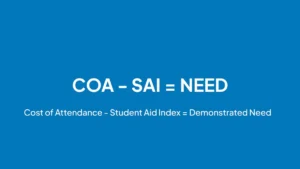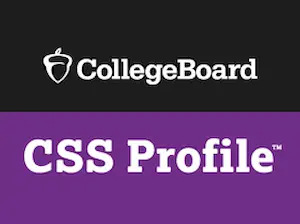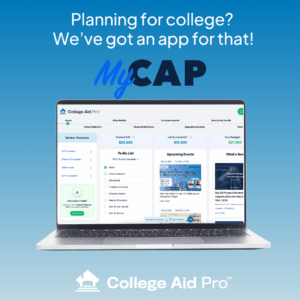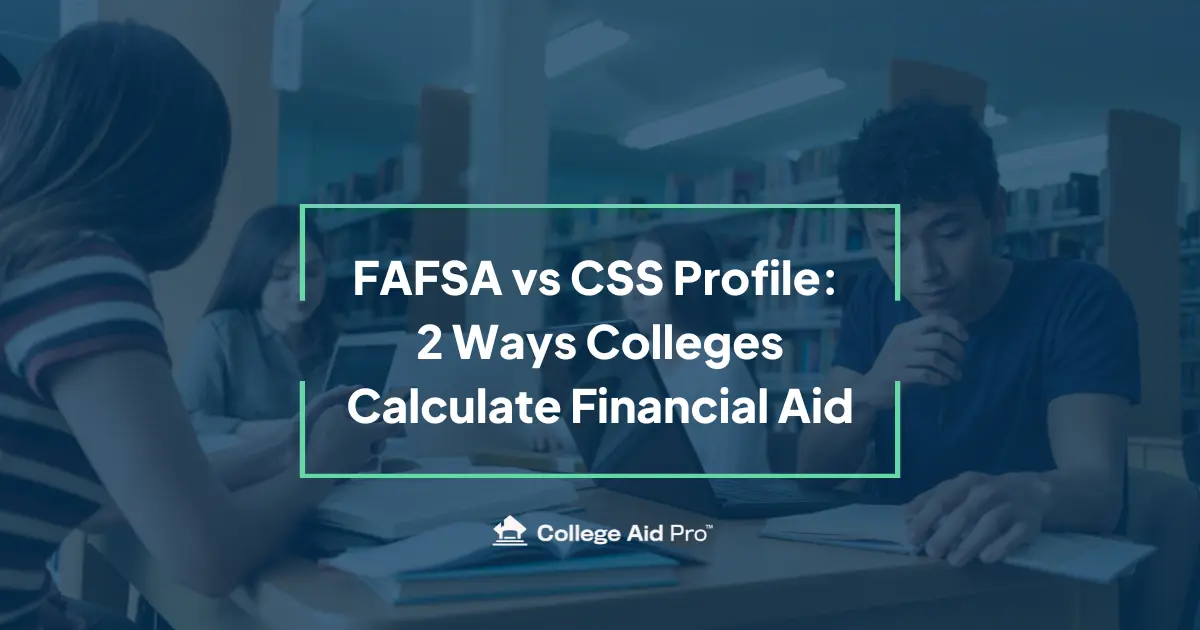FAFSA vs CSS Profile: Two Ways Colleges Calculate Need-Based Financial Aid
Deep breath—we’re going to decode FAFSA vs CSS Profile in plain English so you know why offers differ and how to use both systems to lower your net price.

EFC → SAI: What Changed (and Why It Matters)
Starting in 2024–25, the FAFSA now gives you a Student Aid Index (SAI) instead of the old EFC. It’s a needs-analysis number, not your bill. Lower SAI = higher demonstrated need for federal (and often state) programs.
The core equation:
Cost of Attendance (COA) − Student Aid Index (SAI) = Financial Need

Colleges try to fill that need with a mix of grants, scholarships, work-study, and (if necessary) loans.
Method #1: Federal SAI (FAFSA)

Think of the federal methodology as your baseline. If you file the FAFSA, you get an Student Aid Index (SAI) that colleges use for to assess eligibility for need-based financial aid.
What FAFSA considers
-
Income and certain assets of each required contributor (student, parent/stepparent, or spouse).
-
Primary home equity is not counted.
-
Divorced/Separated/Two-Household? Which parent’s info goes on the FAFSA? The parent who provided more financial support in the past 12 months (include stepparent if remarried).
-
Your SAI can even be negative (as low as –1,500)—that signals very high need.
When FAFSA matters most
-
You’re applying to public universities (which typically don’t require the CSS Profile).
-
You want a clean read on federal grants, loans, and work-study.
-
You’re in early planning mode and need a reliable baseline for your college list.
Method #2: Institutional Methodology (CSS Profile)

Many private colleges use the CSS Profile to award their own institutional grants.
What CSS often considers
-
Primary home equity usually counts as a parent asset (some schools cap it or tie it to income).
-
A broader asset review than FAFSA; colleges may ask for more detail.
-
Noncustodial parent information may be required (policy-dependent).
-
Each college can set nuances within the framework, so two CSS schools can look at the same family and produce different results.
When CSS matters most
-
You’re applying to private colleges that require the CSS Profile.
-
You have substantial home equity or unique financial circumstances.
-
You’re targeting the largest possible institutional grant from a school.
FAFSA vs CSS Profile: Quick Comparison
| Topic | FAFSA (SAI) | CSS Profile (Institutional) |
| Primary home equity | Not counted | Often counted; policy varies by college |
| Which parent(s) | Financially supporting parent (plus stepparent if remarried) | Often includes noncustodial parent (policy-dependent) |
| Primary purpose | Determines federal/state eligibility; informs packages | Allocates the college’s own grant dollars |
Bottom line: If you own a home, FAFSA may show more need than the CSS Profile because home equity isn’t counted on the FAFSA.
Why Your Numbers Don’t Match (And What to Do)
Two systems = two pictures of ability to pay. That’s not an error; it’s design.
-
FAFSA might show more need if you own a home (no home-equity count).
-
CSS Profile might show less need if the college counts home equity or takes a broader look at assets.
Your move: compare net price, not just the size of one scholarship. Prioritize offers that meet more of your need with grants/scholarships (free money) over loans/work (money you repay or earn).
Example: Same Student, Two Outcomes
-
COA: $60,000
-
Federal SAI: $28,000 → Federal “need” = $32,000
-
Institutional methodology (CSS): After counting home equity, the school pegs institutional need at $24,000
Result: The same student might receive more grants at one college and fewer at another—even with similar sticker prices. Always ask: How much of my need is met with grants/scholarships vs loans/work?
Special Cases (Read This If It’s You)
Divorced/separated/two-household families
-
FAFSA uses the financially supporting parent (plus stepparent if remarried).
-
CSS may require noncustodial parent info—check each school’s policy.
High home equity
-
Expect differences. Look up each college’s home-equity cap or formula—this alone can swing awards.
Business/farm owners
-
Report values accurately and consistently. Keep documentation handy; treatments differ.
Use our FAFSA vs CSS Profile Cheat Sheet or Use the MyCAP College Planning Software to calculate your Student Aid Index (SAI) before submitting financial aid applications.
Action Steps to Lower Your Net Price
-
File early and accurately.
-
Check home-equity policy for each college. (Hint: Use MyCAP to do the heavy lifting for you!)
-
Compare projected net costs side-by-side. (Hint: Use MyCAP to do the heavy lifting for you!)
-
Appeal when life changes. Job loss, medical bills, disasters—document it and request a professional judgment review.
-
Stack scholarships. Need-based and merit can play nicely together. Favor renewable awards that reduce your net price every year.
-
Model both methodologies. Run “what-ifs,” compare grants, and build a financially safe college list before you apply.
Turn “FAFSA vs CSS Profile” Into a Lower Net Price with MyCAP
You just learned why the same family can get different offers—FAFSA ignores home equity, many CSS Profile schools count it, and colleges add their own twists. That’s the headache. MyCAP is the aspirin.
Why MyCAP is the move
-
See both methods, side-by-side. Model your FAFSA SAI and the CSS/institutional view so you’re not surprised by home-equity or asset treatment.
-
Build a financially safe college list. Sort schools by net price (not sticker) and by how much of your need they historically meet with grants vs loans.
-
Know each school’s rules. Quickly check home-equity policies, noncustodial parent requirements, and deadlines—no 20-tab rabbit holes.
-
Get real help, fast. Premium members get bi-weekly office hours + member workshops with CAP experts and access to step-by-step tutorials (hello, CSS Profile line-by-line).
Ready to make the math work for you?
-
👉 Become a MyCAP Member (from $4.99/month, cancel anytime)

Spend less time decoding acronyms—and more time saying yes to the right offer at the right price.



